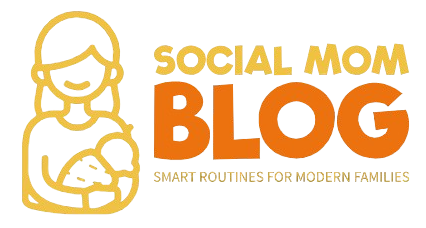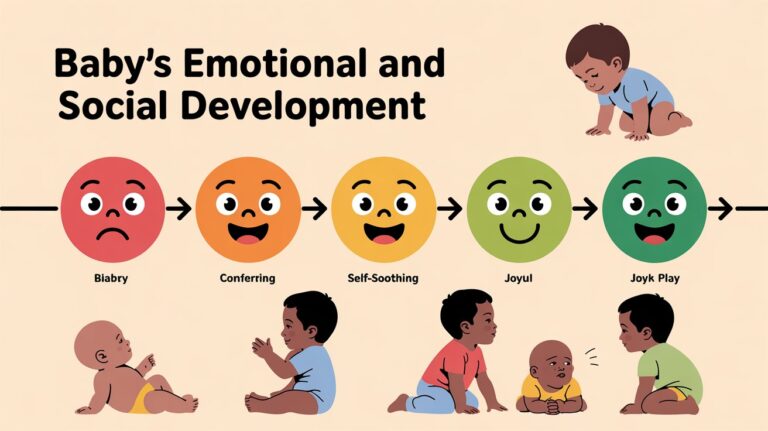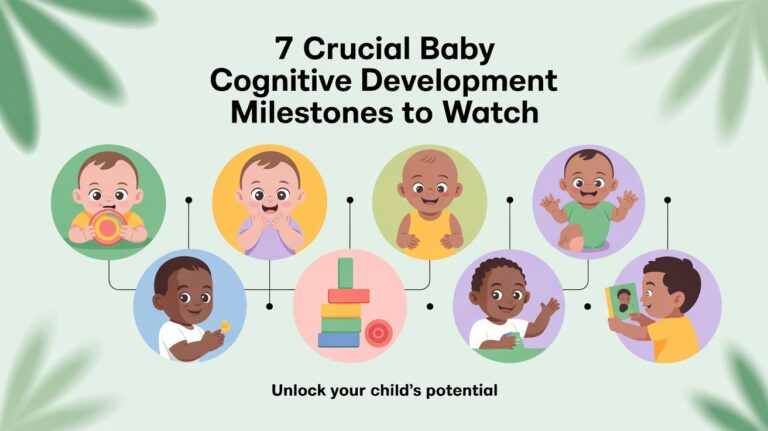7 Powerful Holistic Infant Development Tips: Every Parent Should Know
Holistic infant development is more than just hitting milestones — it’s about nurturing the whole child from the very start. From the moment your baby is born, their brain, body, emotions, and relationships are growing together in powerful and connected ways.
Key Takeaways for Holistic Infant Development
- Whole-Child Growth Matters: Focus on your baby’s cognitive, emotional, social, language, and motor development together; they’re all connected and build on each other.
- Play is Powerful Learning: Engage in play! It’s how babies naturally learn, explore, and integrate new skills across all developmental areas.
- Respond to Their Cues: Responsive parenting—tuning into and acting on your baby’s signals—builds security, helps them manage emotions, and supports healthy brain wiring.
- Know Milestones, Spot Red Flags: Understand typical developmental milestones and be aware of red flags. If concerns arise, talk to your pediatrician; early support makes a big difference.
- Everyday Moments Build Futures: Simple, consistent interactions like talking, cuddling, and reading are your most effective tools. Your presence and connection are everything for their growth.
The early development stages lay the foundation for everything that comes next — thinking, speaking, moving, bonding, and even how they’ll handle stress or build relationships later in life. That’s why pediatric experts like the American Academy of Pediatrics (AAP) and child development leaders like Zero to Three emphasize a full-picture view of infant development — not just focusing on one skill or milestone at a time.
Whether you’re a first-time parent or simply want a clearer baby development guide, understanding how your child’s cognitive, emotional, social, language, and physical systems grow together helps you support them with confidence — and without the overwhelm.
This guide walks you through each core area of development, what to expect by age, signs to watch for, and everyday ways you can support growth at home — all backed by science, experience, and expert insights.
What Does Holistic Infant Development Mean?
When parents ask, “What is holistic infant development?” — they’re really asking how a baby grows as a whole person. Holistic development means supporting your child’s cognitive, emotional, social, and physical growth together, not in isolation.
Your baby’s brain and body aren’t developing in separate silos. They’re deeply connected. When your baby reaches for a toy (motor), they’re also thinking (cognitive), feeling excited (emotional), and often engaging with you (social). That’s integrated brain-body growth in action.
According to the Harvard Center on the Developing Child, “Early experiences shape brain architecture, with positive interactions helping build strong foundations for future learning, behavior, and health.” That’s why things like emotional bonding, secure attachment, and responsive caregiving in the early months aren’t “extras”—they’re essential.
The World Health Organization (WHO) also highlights early nurturing care as a vital factor in healthy development. It’s not just about milestone checklists — it’s about the quality of everyday interactions.
💡 And here’s the magic: play is the glue that holds all of this together. Through play, babies explore their bodies, build brain connections, strengthen relationships, and express emotion — all at once.
Overview of Developmental Domains
Raising a baby goes way beyond tracking their weight or counting diaper changes. As parents, we’re nurturing the whole child — their mind, heart, body, and relationships — from the very beginning. That’s what holistic infant development is all about.
But with so much information (and advice!) out there, it’s easy to feel overwhelmed. Which milestones matter most? How do playtime, emotions, and movement all connect?
In this next section, we’ll break down the 4 core developmental domains every parent should understand: cognitive, emotional/social, language, and motor/sensory development — so you can support your baby in a way that feels informed, balanced, and truly connected.
Cognitive Development: How Babies Think, Explore, and Learn
Baby cognitive development is the foundation of how your child begins to make sense of the world. From recognizing your voice to solving simple problems like shaking a rattle to make sound, early thinking skills grow rapidly in the first two years.
In the earliest months, babies begin developing attention span, learning how to focus on faces, sounds, and eventually, specific tasks. By around 4–7 months, they start to grasp object permanence — understanding that people or things still exist even when out of sight (hello, peekaboo!). This critical milestone signals early memory and awareness.
As infant brain growth accelerates, your child also begins to demonstrate cause-and-effect learning, like dropping a spoon repeatedly just to watch it fall. These small acts build essential problem-solving skills, which are the precursors to logic and decision-making later in life.
Psychologist Jean Piaget first outlined these cognitive leaps as part of the sensorimotor stage, noting how babies learn through hands-on experience. Lev Vygotsky added that social interaction also plays a vital role — babies learn best when supported by responsive adults.
🧠 Want a closer look at early thinking skills? Explore our full guide on Baby Cognitive Development
Emotional & Social Development: Building Bonds That Shape the Future
Infant emotional development begins the moment your baby locks eyes with you — it’s more than sweet snuggles; it’s the brain wiring for lifelong connection. At the same time, your child is starting to hit key baby social development milestones, like smiling at caregivers, showing preference for familiar faces, and eventually learning to imitate emotions.
Psychologist John Bowlby, known for attachment theory, emphasized that a secure, responsive caregiver relationship builds the foundation for emotional safety and social confidence. When a baby cries and a parent responds calmly and consistently, they’re learning a critical skill called co-regulation — the ability to feel safe enough to return to a calm state.
As noted by Dr. Becky Kennedy, emotional development in babies isn’t about avoiding big feelings, but helping children feel seen, safe, soothed, and secure. Babies begin to recognize emotions in others and, by the end of their first year, show signs of empathy — such as becoming upset when another baby cries.
These emotional moments are not small. They are the building blocks for resilience, social intelligence, and trust in future relationships.
🧸 Want real-life strategies to support bonding and social-emotional growth? Check out our full guide on Infant Emotional & Social Development
Baby Language Development Milestones: From Sounds to Meaningful Words
Language development begins long before a baby’s first words. From the moment your infant hears your voice in the womb, their brain is tuning into speech patterns and emotional tone. By the time they’re cooing and babbling, they’ve already laid the groundwork for communication.
Early baby language development starts with joint attention — when your baby looks where you’re pointing or follows your gaze. This seemingly simple behavior is a powerful predictor of future language skills. At the same time, babies begin to develop both receptive language (what they understand) and expressive language (what they say), even if they’re not forming clear words yet.
According to the CDC and the American Academy of Pediatrics, common baby babbling milestones include:
| Age | Typical Language Milestone |
|---|---|
| 3–6 Months | Laughing, cooing, squealing |
| 6–9 Months | Babbling chains like “baba,” “mama” |
| 9–12 Months | Understands “no,” responds to own name |
| 12–18 Months | First words, points to familiar objects |
Naming objects, using repetition, and responding to your baby’s sounds helps build their vocabulary even before they can speak. Inspired by developmental theorist Lev Vygotsky, the back-and-forth nature of parent-child talk — even if it’s just babble — forms the social roots of language learning.
🎯 Want a detailed timeline and expert tips to boost baby’s early speech? Explore our Baby Language Development Milestones guide
Infant Motor Development & Sensory Exploration: Moving Through Milestones
From that first shaky stretch to crawling across the room, infant motor development is how babies gain strength, coordination, and confidence to explore their world. These changes aren’t just physical — they’re foundational for learning, emotional growth, and brain development.
Gross motor milestones like crawling, sitting, and walking help babies build posture, core strength, and spatial awareness. According to the CDC, most babies sit independently by 6–8 months, crawl by 9 months, and take their first steps around 12–15 months.
At the same time, babies refine fine motor skills, like reaching for toys or using the pincer grasp (thumb and forefinger) to pick up small objects — an essential pre-writing skill.
Sensory experiences are the foundation of how babies learn. Simple sensory play like feeling soft blankets, grasping textured rattles, or bouncing on your lap gives vital vestibular input (balance and movement) that supports coordination and brain-body connection.
In the Montessori approach, babies are encouraged to explore through movement and touch at their own pace, with safe, engaging materials that promote independence.
💡 Tummy time from birth helps strengthen neck and shoulder muscles — and is a key activity recommended by pediatricians to prevent flat head syndrome and promote motor development.
🎯 Want simple, development-boosting activities for your baby’s movement and senses? Check out our full guide: Motor & Sensory Development in Babies
Milestone Development by Age
Every baby develops on their own timeline — but there are certain key skills to look for during early growth. Understanding baby milestones by age helps parents know what’s typical, when to celebrate new abilities, and when to ask questions.
Below is a month-by-month developmental milestone chart, summarizing the cognitive, emotional, language, and motor progress most babies make from birth to 24 months.
Developmental Milestones by Age (Source: CDC Milestone Tracker, WHO)
| Age Range | Cognitive Milestones | Emotional & Social | Language | Motor & Sensory | Watch For (Red Flags) |
|---|---|---|---|---|---|
| 0–3 Months | Tracks faces, alert to sounds | Smiles socially, seeks comfort | Coos, different cries | Moves arms/legs, tummy time | No eye contact, limp body tone |
| 3–6 Months | Explores hands, reacts to toys | Laughs, enjoys peekaboo | Babbles, turns to voice | Rolls over, reaches for objects | Doesn’t respond to sounds or smile |
| 6–9 Months | Object permanence emerges | Stranger anxiety begins | Consonant sounds (ba, da) | Sits without help, transfers toys | Doesn’t sit, limited vocal sounds |
| 9–12 Months | Imitates actions, problem-solves | Waves, claps, shows affection | Says “mama”/“dada” meaningfully | Crawls, stands holding furniture | Doesn’t crawl or point, no word usage |
| 12–18 Months | Follows instructions, finds objects | Shows jealousy, tantrums begin | 10–20 words, gestures | Walks alone, uses pincer grasp | Doesn’t walk, no words or gestures |
| 18–24 Months | Sorts objects, simple pretend play | Parallel play, seeks approval | 50+ words, 2-word phrases | Climbs, kicks ball, scribbles | Limited vocabulary, no pretend play |
💡 Note: Missing several milestones may signal a developmental delay. Jump to: Early Intervention Red Flags
The Role of Play in Holistic Development
Play isn’t just something fun to pass the time — it’s the foundation of learning and growth in the early years. According to the Harvard Center on the Developing Child, play strengthens neural pathways, builds problem-solving skills, and shapes the brain’s executive function — the system that helps with focus, self-control, and flexible thinking.
In fact, the American Academy of Pediatrics (AAP) calls play “essential to development,” linking it directly to emotional regulation, physical coordination, and strong parent-child bonds.
Why Play Matters in Every Domain of Development
| Type of Play | Supports This Area | Examples |
|---|---|---|
| Sensory Play | Cognitive & sensory integration | Water tables, texture bins, playing with sand |
| Pretend Play | Emotional growth & empathy | Playing house, dolls, animal role play |
| Active Play | Motor & spatial skills | Crawling through tunnels, dancing, climbing stairs |
| Language Play | Communication skills | Singing songs, rhyming games, storytelling |
| Social Play | Cooperation & emotional bonding | Turn-taking games, peekaboo, group song time |
🧠 Play is how babies practice what they’re learning — without pressure. Through simple activities like stacking blocks or playing peekaboo, infants begin to understand cause and effect, build trust through back-and-forth interaction, and even manage stress.
📌 Research Highlight: Studies show that child-led, unstructured play supports emotional resilience and reduces cortisol levels in toddlers under chronic stress (Harvard, 2020).
From infancy onward, play-based learning becomes the “glue” that connects cognitive, emotional, and physical growth. It’s not an extra — it’s a necessity. Dive deeper into age-appropriate play strategies in: Play-Based Learning for Infants
Red Flags Across Developmental Domains
While every baby develops at their own pace, some signs may indicate a delay that needs closer attention. Recognizing early red flags gives you the chance to get help through Early Intervention Programs, which have been proven to improve long-term outcomes when started early.
According to the CDC, missing key milestones in language, motor, cognitive, or social-emotional growth may be an early sign of a developmental issue.
When to Be Concerned About Development
Here’s a quick breakdown of developmental red flags by domain. If you notice any of these, speak with your pediatrician:
| Domain | Signs of Developmental Delay |
| Language | • No babbling by 9 months • No single words by 15 months • Doesn’t respond to name by 12 months |
| Motor | • Not rolling by 6 months • Cannot sit unsupported by 9 months • No crawling by 12 months |
| Social/Emotional | • No smiling by 3 months • Lack of eye contact • Does not show affection or interest in people |
| Cognitive | • Doesn’t explore objects • Doesn’t imitate gestures • Doesn’t show curiosity about surroundings |
🧠 Regression — losing skills your baby previously had — is also a red flag. For example, if your baby stops using words they previously knew or no longer makes eye contact, consult your doctor right away.
📌 Did You Know? According to Zero to Three, early support services can improve school readiness, emotional well-being, and physical coordination later in life.
👉 If you’re ever unsure, trust your instincts and talk with your pediatrician. Development isn’t a race, but early awareness = early support.
How Parents Can Support Holistic Growth at Home
You don’t need expensive gear or flashcards to raise a thriving baby — you just need presence, consistency, and connection. In fact, research from the Brazelton Touchpoints Center and Zero to Three shows that babies grow best when caregivers practice responsive parenting — tuning in to cues, offering comfort, and creating safe opportunities for learning.
Responsive parenting means you observe your baby’s signals (like fussing, cooing, reaching) and respond in a warm, timely, and nurturing way. This style of caregiving helps regulate stress, build secure attachment, and support healthy brain wiring.
Easy Everyday Ways to Support Development
- Narrate daily tasks: “Now we’re putting on your socks — one foot, two feet!”
- Offer cause-and-effect toys: like rattles, pop-up toys, and shape sorters.
- Play peekaboo: Reinforces object permanence and anticipation.
- Talk, sing, and read aloud — even before they speak.
- Use parentese: That high-pitched, exaggerated voice supports learning.
- Label feelings and actions: “You’re smiling! You like that tickle.”
- Mirror your baby’s expressions — it teaches emotional recognition.
- Hold and rock often: Physical closeness builds trust.
- Practice co-regulation: Stay calm when baby’s upset, so they learn how.
- Do tummy time daily — it strengthens neck, core, and motor coordination.
- Encourage reaching and grasping with safe toys or textured objects.
- Use baby massage or skin-to-skin contact to support sensory development.
Support doesn’t require fancy tools — just everyday connection.
Simple moments like talking during diaper changes or making eye contact during feeding lay the foundation for lifelong learning, empathy, and self-esteem. Your warm, consistent presence is the most powerful tool your baby needs to grow well — across every domain.
FAQs
What is a baby developmental chart?
A baby developmental chart outlines age-based milestones across motor, language, cognitive, and emotional growth. The CDC offers detailed charts to help track progress month by month.
What are the signs of healthy baby development?
Healthy development includes eye contact, babbling, physical growth, responding to sounds, and showing emotions. If your baby is smiling, tracking objects, and meeting age-based milestones, those are good signs.
Can babies learn too early?
No — but overstimulation can be counterproductive. Responsive, play-based engagement is best. According to Zero to Three, babies thrive when learning is social, sensory, and emotionally safe.
What if my baby is behind in a milestone?
Don’t panic — babies develop at their own pace. Talk to your pediatrician. Early intervention can help catch delays and support progress, especially during the critical first 3 years.
When should I worry about developmental delays?
If your baby isn’t babbling by 9 months, doesn’t make eye contact, or stops meeting past milestones, consult your doctor. The CDC estimates 1 in 6 kids under 5 may have a delay.
How do I support emotional development in infants?
Hold, cuddle, make eye contact, and mirror their emotions. These build secure attachment. Emotional bonding fosters trust, resilience, and better brain development.
What are the early signs of autism in babies?
Some signs may include limited eye contact, not responding to name by 12 months, or repetitive movements. Speak with a pediatrician for early screening if you notice these.
Is tummy time really necessary?
Yes! Tummy time strengthens your baby’s neck, shoulders, and arms — essential for crawling and head control. Aim for a few minutes a day starting from birth.
How can I track my baby’s development?
Use milestone checklists from trusted sources like the CDC, AAP, or your pediatrician. Apps and baby journals can also help track feeding, sleeping, and developmental progress.
What helps baby brain development the most?
Talking, playing, reading, and consistent touch. According to Harvard’s Center on the Developing Child, positive caregiver interaction strengthens neural pathways and executive function.




2 Comments